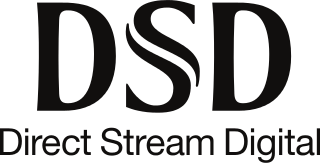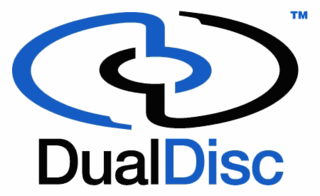
The compact disc (CD) is a digital optical disc data storage format that was co-developed by Philips and Sony to store and play digital audio recordings. In August 1982, the first compact disc was manufactured. It was then released in October 1982 and branded as Digital Audio Compact Disc.

In computing and optical disc recording technologies, an optical disc (OD) is a flat, usually circular disc that encodes binary data (bits) in the form of pits and lands on a special material, often aluminum, on one of its flat surfaces. Its main uses are physical offline data distribution and long-term archival. Changes from pit to land or from land to pit correspond to a binary value of 1; while no change, regardless of whether in a land or a pit area, corresponds to a binary value of 0.

Super Audio CD (SACD) is a read-only optical disc format for audio storage introduced in 1999. It was developed jointly by Sony and Philips Electronics and intended to be the successor to the Compact Disc (CD) format.

DVD-Audio is a digital format for delivering high-fidelity audio content on a DVD. DVD-Audio uses most of the storage on the disc for high-quality audio and is not intended to be a video delivery format.

The LaserDisc (LD) is a home video format and the first commercial optical disc storage medium, initially licensed, sold and marketed as MCA DiscoVision in the United States in 1978. Its diameter typically spans 30 centimetres. Unlike most optical disc standards, LaserDisc is not fully digital and instead requires the use of analog video signals.

Videodisc is a general term for a laser- or stylus-readable random-access disc that contains both audio and analog video signals recorded in an analog form. Typically, it is a reference to any such media that predates the mainstream popularity of the DVD format.

Direct Stream Digital (DSD) is a trademark used by Sony and Philips for their system for digitally encoding audio signals for the Super Audio CD (SACD).
Ripping is extracting all or parts of digital contents from a container. Originally, it meant to rip music out of Amiga games. Later, the term was used to extract WAV or MP3 format files from digital audio CDs, but got applied as well to extract the contents of any media, most notably DVD and Blu-ray discs.
A format war is a competition between similar but mutually incompatible technical standards that compete for the same market, such as for data storage devices and recording formats for electronic media. It is often characterized by political and financial influence on content publishers by the developers of the technologies. Developing companies may be characterized as engaging in a format war if they actively oppose or avoid interoperable open-industry technical standards in favor of their own.

The DualDisc is a type of double-sided optical disc product developed by a group of record companies including MJJ Productions Inc., EMI Music, Universal Music Group, Sony BMG Music Entertainment, Warner Music Group, and 5.1 Entertainment Group and later under the aegis of the Recording Industry Association of America (RIAA). It featured an audio layer intended to be compatible with CD players on one side and a standard DVD layer on the other. In this respect it was similar to, but distinct from, the DVDplus developed in Europe by Dieter Dierks and covered by European patents.

The Criterion Collection, Inc. is an American home-video distribution company that focuses on licensing, restoring and distributing "important classic and contemporary films." Criterion serves film and media scholars, cinephiles and public and academic libraries. Criterion has helped to standardize certain aspects of home-video releases such as film restoration, the letterboxing format for widescreen films and the inclusion of bonus features such as scholarly essays and commentary tracks. Criterion has produced and distributed more than 1,000 special editions of its films in VHS, Betamax, LaserDisc, DVD, Blu-ray and Ultra HD Blu-ray formats and box sets. These films and their special features are also available via an online streaming service that the company operates.
Eight-to-fourteen modulation (EFM) is a data encoding technique – formally, a line code – used by compact discs (CD), laserdiscs (LD) and pre-Hi-MD MiniDiscs. EFMPlus is a related code, used in DVDs and Super Audio CDs (SACDs).

DVD authoring is the process of creating a DVD video capable of playing on a DVD player. DVD authoring software must conform to the specifications set by the DVD Forum.

Extended Resolution Compact Disc (XRCD) is a mastering and manufacture process patented by JVC for producing Red Book compact discs. It was first introduced in 1995.

Mini CDs, or pocket CDs, are CDs with a smaller diameter and one-third the storage capacity of a standard 120 mm disc.
Moser Baer was an Indian multinational manufacturer of optical discs, storage devices, CDs, DVDs, based in New Delhi. The company was present in over 100 countries, serviced through 15 marketing offices and representatives, and had tie-ups with other optical media storage manufacturers. Its products were manufactured at its three plants in New Delhi, which employed over 8,000 people. The company has subsidiaries that manufacture photovoltaic cells and modules using crystalline silicon and thin film technologies.

RITEK Corporation manufactures optical discs such as CD-R, CD-RW, DVD-R, DVD-RW, DVD+R, DVD+RW, DVD-RAM, HD DVD, Blu-ray Disc and Blu-ray M-Disc, storage cards such as CF (CompactFlash) cards, SD cards and MMC cards (MultiMediaCard), memory stick and consumer electronics. Ritek also produces solar modules and touch panel products such as passive matrix OLED and ITO glass. Ritek has also launched a few products in nano- and biotechnology.

HD DVD is a discontinued high-density optical disc format for storing data and playback of high-definition video. Supported principally by Toshiba, HD DVD was envisioned to be the successor to the standard DVD format.
A digital copy is a commercially distributed computer file containing a media product such as a film or music album. The term contrasts this computer file with the physical copy with which the digital copy is usually offered as part of a bundle. It allows the disc's purchaser to acquire a single copy of the film on digital device such as a personal computer, smartphone, tablet computer, or digital media player, and view it on those devices without requiring access to the physical media. "Digital copy" is also commonly referred to as "Digital HD".











